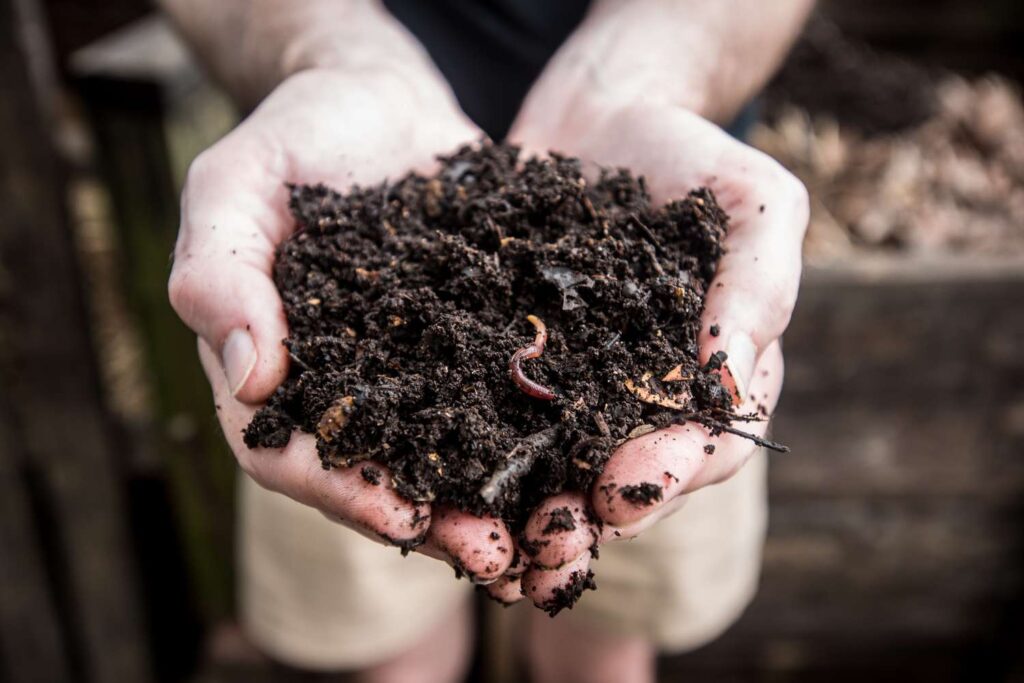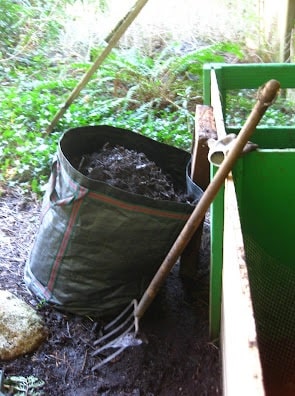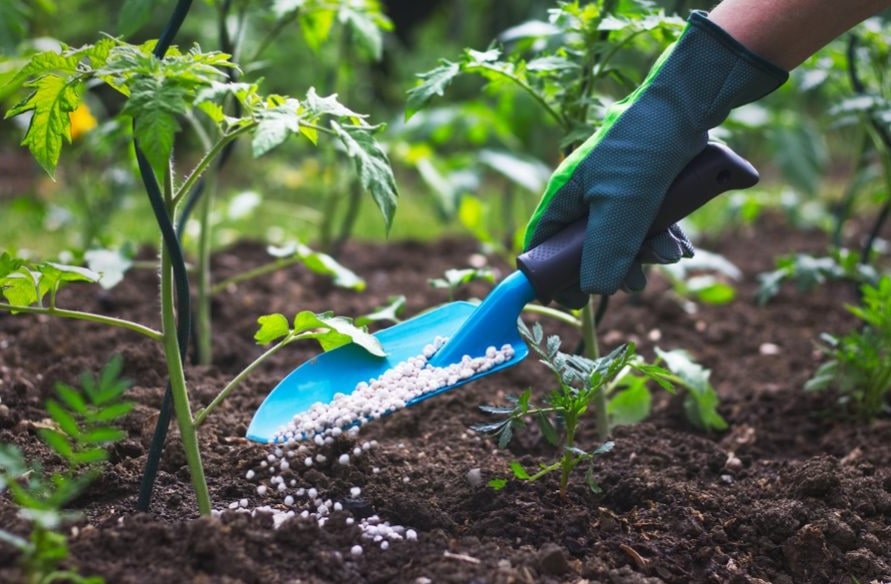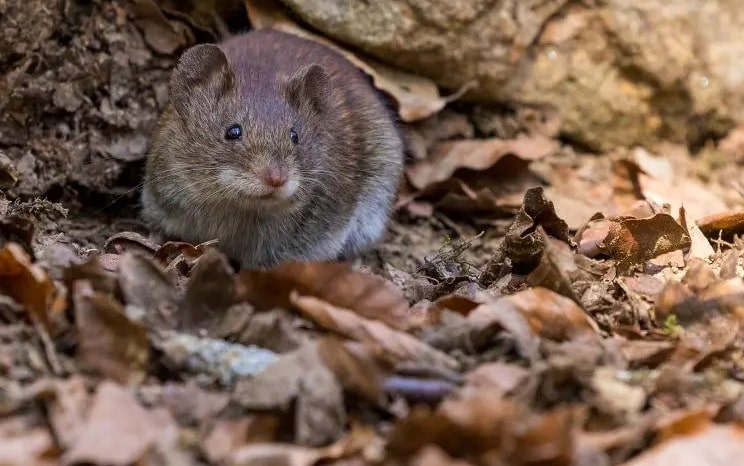Problem: If your compost is too wet, it can lead to a lack of aeration, foul odors, and slowed decomposition.
Solution: To address overly wet compost, follow these steps:
- Drain Excess Liquid: If you notice standing liquid in your compost, remove it using a bucket or by creating drainage channels to allow excess moisture to escape.
- Add Dry Brown Materials: Incorporate carbon-rich brown materials like dry leaves, straw, or shredded newspaper to help absorb excess moisture and restore the carbon-to-nitrogen balance.
- Turn and Aerate: Regularly turn the compost pile to introduce oxygen, which will aid in drying out the pile. Proper aeration helps the compost dry more evenly.
- Cover the Compost: Use a cover or tarp to protect the compost from rain and additional moisture. Make sure the cover allows for airflow.
- Monitor Moisture: Keep an eye on the moisture level and adjust as necessary to maintain a damp, but not soggy, consistency.
Contents
- 0.1 How to Revive Dry Compost
- 0.2 Why Is My Compost Wet and Not Hot?
- 0.3 Why Is My Compost Wet and Clumpy?
- 0.4 How to Save Sludgy Compost
- 0.5 Is It OK for Compost to Get Wet?
- 0.6 Why Is My Compost So Wet and Smelly?
- 0.7 Are Newspapers Good for Compost?
- 0.8 Three Things You Shouldn’t Compost
- 0.9 Can You Compost Tea Bags?
- 0.10 Is It OK to Put Shredded Paper in Compost?
- 0.11 Can I Use Brown Paper Bags in My Compost?
- 0.12 Can You Put Cardboard in Compost?
- 0.13 Can You Compost Egg Cartons?
- 0.14 Can I Compost Toilet Paper Rolls?
- 0.15 Can I Put Moldy Bread in Compost?
- 0.16 Can You Put Banana Peels in Compost?
- 0.17 Can You Put Apples in Compost?
- 0.18 Can You Compost Onions?
- 0.19 What Fruit Cannot Be Composted?
- 0.20 Where Should Compost Be, in Sun or Shade?
- 0.21 What Leaves Should Not Be Composted?
- 0.22 Can I Keep Adding to My Compost Pile?
- 0.23 When Should You Not Use Compost?
- 0.24 Which Is Better: Leaf or Mushroom Compost?
- 1 Author
How to Revive Dry Compost
Problem: Dry compost can lead to slow decomposition and an inactive pile.
Solution: To revive dry compost, follow these steps:
- Add Water: Sprinkle water evenly over the compost pile to reintroduce moisture. Ensure that the compost reaches the moisture level of a wrung-out sponge.
- Mix and Turn: After adding water, thoroughly mix the compost to distribute the moisture evenly. Turning the pile helps aerate it and allows moisture to penetrate the center.
- Cover: Use a cover or lid to retain moisture in your compost pile and protect it from drying winds and direct sunlight.
- Adjust the Ingredients: If your compost remains too dry, evaluate the balance of green and brown materials. Add more green materials to increase moisture content.
- Monitor and Maintain: Regularly check the moisture level of your compost and make adjustments as needed to maintain the right balance.
Why Is My Compost Wet and Not Hot?
If your compost is wet but not heating up, it could be due to excessive moisture, which can inhibit microbial activity. The excess moisture displaces the oxygen needed for the aerobic decomposition process, causing the pile to remain cool. To address this issue, follow the steps outlined above for managing wet compost, ensuring proper aeration, and balancing the carbon-to-nitrogen ratio.
Why Is My Compost Wet and Clumpy?
Clumpy and wet compost can result from inadequate aeration and the compression of materials. To improve this situation, turn the compost pile to introduce oxygen and break up the clumps. Additionally, add dry brown materials to help absorb excess moisture and create a more uniform consistency.
How to Save Sludgy Compost
Sludgy compost, which is often soggy and foul-smelling, requires immediate attention. Follow these steps to save sludgy compost:
- Drain Excess Liquid: Remove standing liquid from the compost pile, if present.
- Add Dry Materials: Mix in dry brown materials, such as dried leaves or straw, to absorb excess moisture and balance the carbon-to-nitrogen ratio.
- Turn and Aerate: Regularly turn the compost to introduce oxygen and break up clumps. This aids in even drying and decomposition.
- Cover: Use a cover or tarp to protect the compost from rain and further moisture.
- Monitor Moisture: Keep a close eye on the moisture levels and adjust as needed to maintain the right balance.
Is It OK for Compost to Get Wet?
Compost can tolerate some moisture, but excessive wetness can lead to issues like anaerobic conditions, bad odors, and slower decomposition. It’s essential to maintain the right moisture level, similar to a wrung-out sponge, to support healthy composting. Proper aeration and the addition of dry brown materials can help manage excess moisture and keep the compost pile in good condition.
Why Is My Compost So Wet and Smelly?
Wet and smelly compost is often the result of anaerobic conditions, where the compost pile lacks sufficient oxygen for aerobic decomposition. The excess moisture displaces oxygen and promotes the growth of odor-producing anaerobic bacteria. To address this issue, take steps to drain excess liquid, add dry materials, turn the compost for aeration, and cover it to maintain a more aerobic and less smelly environment.
Are Newspapers Good for Compost?
Newspapers can be used in compost, but they should be added in moderation. Newspaper is a carbon-rich brown material that can help balance the carbon-to-nitrogen ratio in your compost pile. However, it’s essential to shred or tear the newspaper into smaller pieces to facilitate decomposition. Avoid adding colored or glossy pages, as they may contain inks or chemicals that are less suitable for composting.
Three Things You Shouldn’t Compost
- Meat and Dairy Products: Meat, fish, and dairy items can attract pests and release unpleasant odors when composted. They are best avoided unless you have a specialized composting system designed to handle them.
- Diseased Plants: Avoid composting plants that are diseased, as the pathogens may survive the composting process and spread to your garden when you use the finished compost.
- Pet Waste: Pet waste, such as cat or dog feces, should not be composted in a traditional backyard compost pile because it can contain harmful pathogens. It’s safer to dispose of pet waste separately or consider using a specialized pet waste composting system.
Can You Compost Tea Bags?
Yes, you can compost tea bags, but it’s essential to choose tea bags made from materials that are suitable for composting. Many tea bags are now made from biodegradable materials like paper or plant-based fibers. Remove any staples or tags, and then tear or cut the tea bags into smaller pieces to facilitate decomposition. Avoid tea bags with plastic or non-biodegradable components.
Is It OK to Put Shredded Paper in Compost?
Shredded paper can be added to compost, but like newspaper, it’s a carbon-rich brown material. To compost shredded paper effectively, mix it with other green and brown materials and ensure it’s adequately moistened. Shredded paper is an excellent way to balance the carbon-to-nitrogen ratio in your compost pile.
Can I Use Brown Paper Bags in My Compost?
Brown paper bags can be composted, provided they are made from unbleached and non-coated paper. Tear or shred the bags into smaller pieces for faster decomposition. Brown paper bags are a source of carbon for your compost, helping balance the carbon-to-nitrogen ratio.
Can You Put Cardboard in Compost?
Cardboard can be composted, but it should be broken down into smaller pieces or shreds for efficient decomposition. Like brown paper, cardboard is a valuable source of carbon in composting. Avoid cardboard with glossy or plastic coatings, as these materials are not suitable for composting.
Can You Compost Egg Cartons?
Egg cartons made from cardboard or paper can be composted. Break them into smaller pieces to speed up decomposition. As with other paper products, avoid egg cartons with plastic or foam components, as these are not suitable for composting.
Can I Compost Toilet Paper Rolls?
Toilet paper rolls, which are made of cardboard, can be composted. Tear them into smaller pieces before adding them to your compost pile to facilitate decomposition. Like other paper products, they serve as a valuable source of carbon.
Can I Put Moldy Bread in Compost?
Yes, you can add moldy bread to your compost pile. The decomposition process will break down the mold, and the bread will contribute to the overall organic matter in your compost. However, ensure the compost pile has the right carbon-to-nitrogen balance and is properly aerated to prevent the growth of additional molds.
Can You Put Banana Peels in Compost?
Banana peels are excellent for compost. They are rich in nitrogen and will help balance the carbon-to-nitrogen ratio in your pile. To speed up decomposition, you can cut or tear them into smaller pieces before adding them to the compost.
Can You Put Apples in Compost?
Apples are compostable and contribute to the green materials in your pile, providing nitrogen. As with other kitchen scraps, cutting them into smaller pieces can help speed up decomposition.
Can You Compost Onions?
Onions are compostable, and they add valuable nutrients to your compost pile. They are considered green materials and provide nitrogen. Chopping or dicing onions before composting them can enhance the decomposition process.
What Fruit Cannot Be Composted?
While most fruit waste can be composted, citrus fruits like oranges and lemons can be more challenging to compost due to their acidity. It’s best to add citrus scraps in moderation, as excessive citrus waste can alter the pH of your compost. Additionally, avoid composting fruit waste that has been treated with pesticides or chemicals.
Where Should Compost Be, in Sun or Shade?
Compost bins or piles can be placed in either sun or shade, but each location has its advantages and considerations.
Sun: Composting in a sunny location can help accelerate the decomposition process. The warmth from the sun can speed up microbial activity and reduce the time it takes for compost to mature. However, you’ll need to monitor the moisture level more closely, as the sun can dry out the compost more quickly.
Shade: Composting in a shaded area can help maintain more stable moisture levels, preventing the compost from drying out too rapidly. However, the decomposition process may be slower in the shade due to the cooler temperatures.
Ultimately, the choice of sun or shade depends on your climate and composting goals. Both can work, but you may need to make adjustments to accommodate the conditions of your chosen location.
What Leaves Should Not Be Composted?
In general, most leaves can be composted, but some should be added with caution:
- Walnut Leaves: Black walnut leaves contain natural chemicals that can inhibit the growth of other plants. While they can be composted, it’s best to use them in moderation and ensure they are well-mixed with other materials.
- Eucalyptus Leaves: Eucalyptus leaves contain aromatic oils that can be allelopathic, meaning they inhibit the growth of nearby plants. Compost them with care and in moderation.
- Pine Needles: Pine needles are acidic and can lower the pH of your compost. While they can be composted, it’s advisable to balance them with other materials to prevent the compost from becoming too acidic.
Can I Keep Adding to My Compost Pile?
Yes, you can keep adding materials to your compost pile over time. This is known as “batch composting.” However, it’s important to maintain a balance of green and brown materials and ensure proper aeration and moisture levels. If you want to create finished compost more quickly, consider starting a second pile or bin and allow the first one to mature.
When Should You Not Use Compost?
Avoid using compost that has not fully decomposed or “cured.” Fresh, unfinished compost can potentially harm your plants due to the release of phytotoxins during decomposition. Mature, well-cured compost should be dark, crumbly, and have an earthy smell. It’s ready for use in your garden, while unfinished compost is best left to continue breaking down.
Which Is Better: Leaf or Mushroom Compost?
The choice between leaf compost and mushroom compost depends on your gardening needs. Leaf compost is excellent for improving soil structure and moisture retention, making it ideal for most garden applications. Mushroom compost, which often includes a mix of organic materials, can be especially rich in nutrients and beneficial microorganisms, making it a valuable soil conditioner. The choice between the two often comes down to your specific gardening goals and the condition of your soil. Both types of compost can be beneficial when used appropriately.









